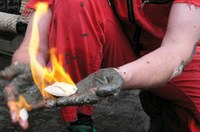 Gas hydrates are water-based crystalline solids containing gas molecules trapped inside lattice-like organic frameworks. Found in abundance beneath the ocean floor and in permafrost regions, they could play a key role in meeting the world's future energy needs.
Gas hydrates are water-based crystalline solids containing gas molecules trapped inside lattice-like organic frameworks. Found in abundance beneath the ocean floor and in permafrost regions, they could play a key role in meeting the world's future energy needs.
Harsh K. Gupta has been conducting research on gas hydrates for the past two decades. As director of the National Geophysical Research Institute, Hyderabad, India, he initiated an assessment of gas hydrates in India's exclusive economic zone (EEZ) that served as the basis for mapping the thickness of hydrate coastal deposits along India's coastline. The assessment was based on existing geophysical and geological data.
"Gas hydrates could serve as an important source of energy in the future," says Gupta, "but we must find techniques for extracting this resource in economically and environmentally sound ways."
Gupta, former secretary of the Department of Ocean Development in India and current president of the Geological Society India, has earned an international reputation in the field. In addition to his research, he has helped convince policymakers and energy executives that conventional methods of oil exploration, which rely on drilling originating at the ocean surface, may not be the best way to explore for gas hydrate deposits.
Instead, he has encouraged the development of a remotely operated underwater vehicle (ROV) to roam – and sample – the ocean bottom for signs of gas hydrates. Once a ROV identifies a promising location, a drilling outfit could be lowered to the ocean floor. "This," Gupta says, "would be a more economical way to conduct the search." India's National Institute of Ocean Technology in Chennai has taken the lead in developing such a device.
Gas hydrates consist of a solid mixture of water and light hydrocarbons, mainly methane, that is created through a process driven by high pressure and low temperatures – conditions that exist in such harsh environments as ocean floors and the permafrost.
"India is the fourth major consumer of fossil fuels in the Asia-Pacific region," says Gupta. "Only China, Japan, and South Korea use more." And the country's consumption levels are on pace to more than double over the next 20 years due to population growth and increased wealth. "To meet the growing demand for fossil fuels," he says, "India must aggressively pursue a mix of energy policies that both promote efficiency and increase supplies."
According to experts, the carbon content found in known gas hydrate reserves is double the carbon content in all known reserves of fossil fuels worldwide.
Gupta notes that India, recognizing the potential importance of this resource, has established a national gas hydrates programme. In its early stages of operation, the programme is gathering data on existing supplies within the country's borders and exploring possible new technologies for its extraction and production.
India's EEZ, which according to the Law of the Sea extends 370 kilometres from the ocean shoreline, has yet to be comprehensively explored for the extent of its natural resources, including gas hydrates. International accords give each country special rights for the exploitation of resources within its EEZ.
Despite a lack of data, Gupta notes that investigations conducted by him and his colleagues indicate that large quantities of gas hydrates reside within India's EEZ, and that as little as 1% of the methane located inside the crystalline molecules could meet India's energy needs for the next decade. Supplies of gas hydrates are especially plentiful in the Krishna River and Godavari River basins in the state of Andhra Pradesh along the southeastern coast of India.
But these supplies will prove of little use unless they can be economically and safely extracted.
"At standard temperatures and pressures," Gupta explains, "gas hydrates become unstable and cannot be used as fuel." Consequently, simply extracting gas hydrates with existing technologies will serve no purpose. "We need to develop new technologies that will retain the integrity of the resource in ways that will allow it to be exploited," says Gupta. "This will require additional research, as well as investments in technologies with the potential to reach the marketplace."
"The scope of the challenge," he observes, "is matched by the sense of urgency we now face in meeting present and future energy demands both in India and throughout the world."

